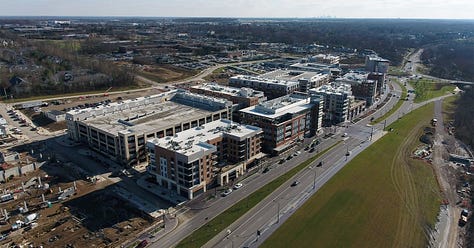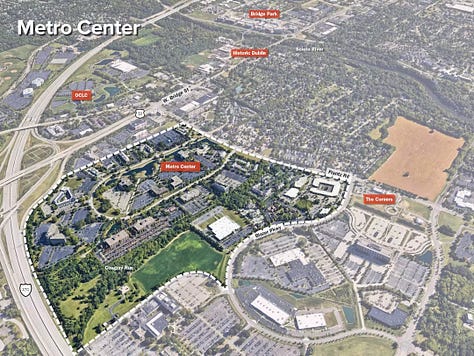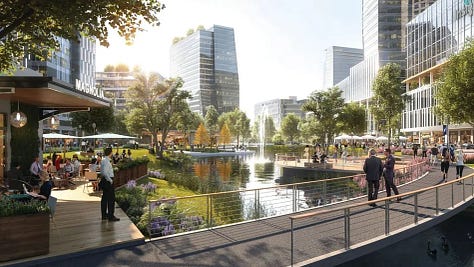It's Time for Some Nuance on the Debate about "Sprawl"
Housing people is #1. New greenfield housing doesn't have to be the same as it was in the 1990s.
I grew up in “sprawl.” My house was one of the first built in my subdivision, which had been a cornfield, just inside Columbus’ I—270 outer belt.
The development was “tract” housing. Our house was four bedrooms, not big enough to qualify as a McMansion, but in the same building style, I would say. There were no mature trees, except in our backyard, which had been a fence line in the corn (or soybean?) field. Prior to us moving in, birds sat there and crapped out seeds that became these really mangey trees that no one would ever plan and plant, but that shaded our backyard while I was growing up. It was not unusual, the whole time I was growing up, to be at someone’s house or someplace, and have it be right next to an active farm.
This probably sounds kind of ungrateful in retrospect because it’s not like I had a truly deprived childhood. It was even privileged a little I guess. But I sorta hated it, that environment. It was legit lacking in important ways. I think that’s why I got into writing about planning. I was very adventurous and there was no where to go. It was like my whole spirit was rebelling against the confines of the space. And it was pretty limiting, especially before I could drive. There wasn’t any privacy for kids. And there wasn’t much stimulation.
As I got older, eventually, I figured out how to walk to some retail, by cutting through yards and walking in a ditch beside a busy road. I even hopped aboard a bus one time and took it downtown. But there was barely any public space. Even when I was a child I used to complain about it. And I dreamed of living in a rural area or an urban area, which I thought was better. When I graduated I did move to and have lived in urban areas ever since.
When I was in grad school, I became kinda obsessed with sprawl. At the time I was living in Cleveland, a shrinking metro area. And the region was still sprawling, even though the urban areas were undergoing a vacancy crisis. It was, I thought, a zero-sum game. Every tract house built in a greenfield was a house that would become empty in Cleveland or East Cleveland. The pattern just widened inequality and hurt the environment and increased infrastructure costs. So I was pretty scold-y on this topic and spent a lot of my career thinking and writing about it.
More recently, however, my views on this have softened. When I think about my parents, where they moved when I was young, what role that house played in our lives. It might not have been that classy, compared to like some Georgetown townhouse, or whatever the theoretical idealized alternative was, but it was what they could afford. They had to be strategic, because that investment in the house was the largest they ever made. Really the only “capital” they owned, and they were very conscious of it.
In Columbus, in the decades since, there have been thousands of houses built in subdivisions like it stretching for nearly 10 miles past the outer belt now. Columbus gets criticized for being “boring.” And I don’t think there’s nothing to that. But, say what you will, it is a city that has managed to thread the needle on having both healthy job growth and relatively affordable housing and a big middle class (although that is under increasing pressure as of late.)
I was talking to a cousin of mine who lives there recently. She’s working for a building company whose goal is to build 1,000 housing units this year. They are are “sprawl” style, like Ryan Homes. Pre-fab, can be slightly modified to build to suit. She said they specialize in getting people who have never owned a home into a house. And they’re building in areas like Zanesville that have big new job hubs but not enough housing. My dad now, lives in an area like that outside of Columbus.
They have added 10,000 low-wage manufacturing and distribution jobs in the last decade or so. But almost no housing. And the workers are making these crazy super commutes from as far away as Dayton and Springfield.
The complaints I had about my neighborhood as a kid… they still are valid I would say. I don’t think there was nothing to them. My family, we had arrived in that thrown up, relatively unplanned living area, from the Toledo metro area, which has been on a 50 year economic decline. And I do think it was lacking in some ways. We struggled I think to become rooted there. Of the four of us in my immediate family, only one of us remains there, in the metro area. It didn’t have a lot of centers of a community like an older place would have, outside of the schools. Mostly everything was commercial. It’s the American way.
When I graduated from high school, it didn’t seem like I had much option but to leave the little suburb I was from, in order to live a good life and grow. It wasn’t a multi-generational community. It was a bedroom community for families more. Plus, I was, as I mentioned, adventurous. I wanted to get out and experience different places. So for some people, maybe, they would have been satisfied to stay forever, and that might have worked, like say, if they lived with their parents or got married very young.
It’s funny. The suburb I grew up in, it’s called Hilliard (pronounced Hill-YERD ha) was sort of the stereotypical sprawl suburb. But it has been evolving a little bit. I was driving out through some of the outer edges of the community recently, and I noticed something unusual. Someone had made a big effort to make safe crosswalks connecting the high school to some market rate affordable-ish apartments nearby. Sprawl apartments. When I see “sprawl style” apartments and they aren’t connected to anything it breaks my heart. It’s the worst of both worlds I think, none of the benefits of single family housing, without any of the connection and walkability that could come from density.
Seeing that little connection made me so hopeful. Connecting people who live in those affordable apartments to the school by foot, even way out in the sprawl, to me it seemed like a big step forward, a small practical change that could make people’s lives better. I know their transportation director for Hilliard a little bit now and I think she’s sorta heroic. She fully “gets it.”
Some of the suburbs of Columbus — which were peak 1990s stereotypical sprawl — have really gotten the message about smart growth. The key one is Dublin, which is right next to Hilliard where I grew up.
Dublin was always way ahead of the curve on government management. It was one of the first suburbs to really pioneer “job sprawl.” It used tax breaks in the 1990s and 2000s to lure so many employers that it had a bigger daytime population than nighttime. It used the tax revenues from that to offer its residents (who were mainly high income) low taxes and great services. This was the model every suburb in Ohio tried to emulate for decades — many with a good deal of success.
More recently, however, Dublin shifted its whole approach. And it was, again, ahead of the curve, imo. In 2007, it took 1,000 acres in the middle of the city, including its original historic downtown, to build a walkable, mixed-use center, with retail and office and hotel and garaged parking. The suburb has been urbanizing.



It is now preparing for a big expansion. New plans call for bringing high(ish) frequency transit out to this part of Dublin.
Dublin’s success, once again, has influenced suburbs around the Columbus area, who have invested in their historic downtowns and made them walkable gathering places. Hilliard has done some really cool things in their downtown.
Keep reading with a 7-day free trial
Subscribe to Unpopular Opinions to keep reading this post and get 7 days of free access to the full post archives.



